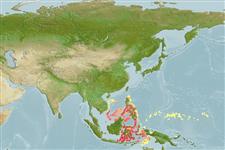Classification / Names
Nombres comunes | Sinónimos | Catalog of Fishes(Género, Especie) | ITIS | CoL | WoRMS | Cloffa
>
Eupercaria/misc (Various families in series Eupercaria) >
Cepolidae (Bandfishes) > Owstoniinae
Etymology: Owstonia: Named for Alan Owston (1853‒1915), an amateur naturalist, yachtsman and collector of Asian wildlife, notably fishes from Japan and China..
Environment: milieu / climate zone / depth range / distribution range
Ecología
marino demersal; rango de profundidad 184 - 186 m (Ref. 119093). Tropical
Western Central Pacific: Philippines.
Tamaño / Peso / Age
Maturity: Lm ? range ? - ? cm
Max length : 6.8 cm SL macho / no sexado; (Ref. 119093)
Life cycle and mating behavior
Maturities | Reproducción | Spawnings | Egg(s) | Fecundities | Larva
Smith-Vaniz, W.F. and G.D. Johnson, 2016. Hidden diversity in deep-water bandfishes: review of Owstonia with descriptions of twenty-one new species (Teleostei: Cepolidae: Owstoniinae). Zootaxa 4187(1):1-103. (Ref. 119093)
IUCN Red List Status (Ref. 130435)
Threat to humans
Harmless
Human uses
Herramientas
Special reports
Download XML
Fuentes de Internet
Estimates based on models
Phylogenetic diversity index (Ref.
82804): PD
50 = 0.5000 [Uniqueness, from 0.5 = low to 2.0 = high].
Bayesian length-weight: a=0.01000 (0.00244 - 0.04107), b=3.04 (2.81 - 3.27), in cm total length, based on all LWR estimates for this body shape (Ref.
93245).
Nivel trófico (Ref.
69278): 3.2 ±0.4 se; based on size and trophs of closest relatives
Resiliencia (Ref.
120179): Alto, población duplicada en un tiempo mínimo inferior a 15 meses (Preliminary K or Fecundity.).
Fishing Vulnerability (Ref.
59153): Low vulnerability (10 of 100).
